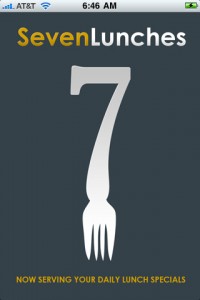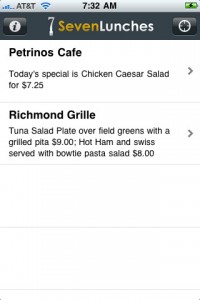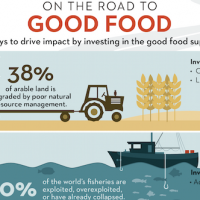Meet Jeff Lee, Co-Founder of 7Lunches, a digital advertising service that allows restaurants to share their daily specials, in 140 characters or less, with local diners through email, mobile applications, sevenlunches.com, and social media platforms.
Is 7Lunches just another Groupon, Living Social, or Yelp? According to Lee, 7Lunches is vastly different from these services in that it provides restaurants with a cross-platform, daily marketing tool, “made easy.” Even so, working with restauranteurs, many of whom are technologically averse and are already inundated with marketing materials from the aforementioned companies, is no easy fete. I am definitely interested to follow the company’s success, which will largely be contingent on their ability to increase customer acquisition, both restaurants and diners. I got a chance to speak with Lee about the site, their business model, and the challenges he and his team face in building out their customer base.
Danielle Gould: What was the inspiration for Seven Lunches?
Jeff Lee: The inspiration came when our founder Ryan Maturski was at a local sandwich shop in North Adams, MA for lunch. He asked the owner if he had an E-mail list and if he ever sent out E-mails to that list featuring the daily specials. During that same lunch he thought of the idea to build a simple system that let restaurants post their daily specials to a website. The website would then send out a single daily E-mail with all the nearby specials to people right around the time they decide what they’re doing for lunch. He began planning and building the site that afternoon following his lunch.
DG: How does the app work?
JL: Very simply, the app uses GPS to find the user’s location, and shows them specials based on where they are. Alternately the user can choose their home zip code, or enter a zip code if they are using an iPod touch, iPad or non GPS device. More features are being built that I can’t talk about right now.
DG: Could you describe the value proposition for restaurants? How difficult has it been to sign up restaurants?
JL: The value proposition is local daily digital marketing made easy. We know restaurant management is a time intensive business, and we want to help them promote better, and save some time doing it. The idea is to promote themselves to multiple digital platforms daily (web, email, mobile, their social media profiles) via a single 140 character message, tied into a single dashboard, and spend less than an hour total per week doing it.
As far as the difficulty signing up restaurants, a salesforce and customer service team on the ground would certainly help us grow faster. But most of the problems we face in are due to the time restraints of restaurant owners and managers, and/or a lack of web/social/mobile technology knowledge in the restaurant industry. Some restaurants I go to are enthusiastic and embrace it immediately. Normally these are the restaurants who already use facebook and twitter, and get what we are trying to do to help them. But some just don’t know technology that well and look at all this new technology coming at them almost daily as a hassle, and something they don’t have time to learn. 7Lunches trying to break down that barrier by making all of this easier for them. Smartphones and tablets going mainstream is really helping our cause.
 DG: Who and how large is your target market?
DG: Who and how large is your target market?
JL: 7Lunches’ target market is all restaurants and people who love food and specials. Everybody has to eat, but people like myself; a foodie who loves to cook, and find the greatest local restaurants wherever I happen to be.
According to the National Restaurant Association, there are approximately 960,000 eating and drinking establishments in the United States. 90% of which are single unit operations (not chains). We have also found through our own research that about 40% of US restaurants do not have their own website, and a good portion of the remaining 60% who do have their own website, many have been neglected for years. We see this as a big opportunity.
We are still doing research on market sizes and population data outside the US, but this concept could easily be expanded to every country in the World that has Internet technology. Food is a universal language.
DG: How do you incentivize user engagement?
JL: We are exploring many ways to reward our users to refer new restaurants, or restaurants to get more diners to sign up. But our best pitch to them is always this: the more people you get to sign up on both sides of the table, the better 7Lunches will work for everyone including yourself.
DG: What is your business model or what models are you exploring?
JL: We are using a freemium and advertising business model. Currently we are in beta so it is 100% free for a restaurant to sign up. But that may eventually change, and we may make some upcoming features part of a premium package.
We’ve found that local businesses spend on average about $500 per month on marketing. If we can get a small portion of what was going to newspapers, TV, Radio, mailers, coupon packs, circular ads etc. and can give restaurants daily local advertising on multiple digital platforms to permission based opt-in customers near them, then we can win a piece of that budget.
Our entire service is essentially advertising so in addition to the core service of daily specials and restaurant promotion, we will likely offer targeted advertising on the site, in our apps, and our E-mails as we grow. Some of this is already in place in the apps.
 DG: What are the most interesting, unexpected things you have learned?
DG: What are the most interesting, unexpected things you have learned?
JL: The demand for the app is one of the more interesting things I’ve seen. We now have GPS based iPhone and Android apps, but originally we started out as an E-mail & SMS alert system for specials based on the users home zip code. After all, just about every phone can get a text or E-mail these days right? But everytime I went to a restaurant, an event, talked to a friend, or potential investor they all asked: “Do you have an app?” To which I replied that everything is done through E-mail or text messaging, and we had a mobile friendly site, so it works with almost every phone out there. But I kept getting grilled on why we didn’t have an app. So we built an iPhone app and then the question became: “When are you coming out with an Android app?” So we’re proud to say we now have an Android and iPhone app, and we’re going to do even more cool stuff with both apps in the coming months.
The other thing is tailoring the system for restaurant people and their time constraints. Most really love our concept, but literally have no extra time to spend on much of anything. So we have had to make that a focus of design and our customer service. Their restaurant is their life, they spend 80+ hours a week working there. They practically live there. So usually their website, online promotion, and social media is a side project that falls on the heads of a young staff member or relative who knows a little about web design who’s doing it for some extra money or as a college project or internship. These people come and go, and when they go, the website and online promotion suffers. They know marketing is important, but have let it slide, or haven’t tried anything new in a while. So we teach them how to use our system, listen to their feedback, and implement much of it back into our system. We have learned a ton from our restaurants and users.
DG: What have been your greatest challenges?
JL: This may sound like a gripe but probably my biggest challenge or source of frustration has been in getting the tech industry to understand what we’re doing and how it is different. Restaurants and everyday diners get the concept instantly. “One daily E-mail or app notification that lets me know what today’s specials are nearby.”
To some of the big tech sites, VC’s, Angels, startup competitions, incubators, etc. who don’t live in the restaurant/food space, 7Lunches sounds too much like Groupon, LivingSocial (and clones), Foursquare, or Yelp! They say to me “well you’ll have a hard time competing with company X” like this game is already over. I can tell them several reasons why Company X isn’t a great daily solution for a restaurant and how we’re not really in direct competition with Company X. Local advertising is a huge space with lots of opportunity and we are offering a valuable service to restaurants that lets them reach customers daily. It may not be the sexiest idea ever thought up, but why does it have to be? It’s real and it works.
DG: What’s your ultimate goal?
JL: To become a digital advertising standard and have every restaurant in every corner of the known world using (and loving) our service, with tens or hundreds of millions of diners receiving E-mails and app alerts daily. We could really disrupt the local and national advertising space by leveling the playing field in any local market, and do it daily. We may also expand beyond food to other local businesses that make sense for this type of daily advertising.





